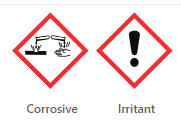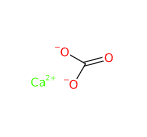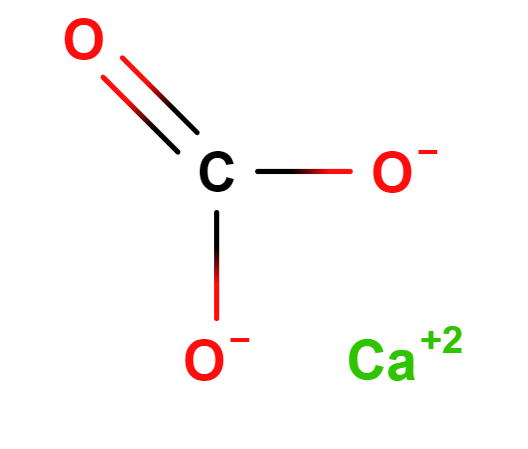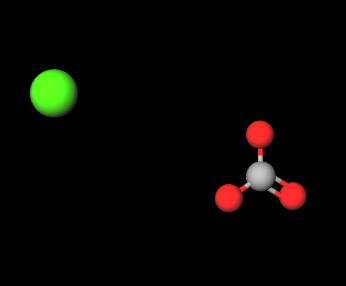Check the ingredients!
... live healthy!


| "Descrizione" by Handy23 (4270 pt) | 2023-Jul-15 16:33 |
| Evaluation | N. Experts | Evaluation | N. Experts |
|---|---|---|---|
| 1 | 6 | ||
| 2 | 7 | ||
| 3 | 8 | ||
| 4 | 9 | ||
| 5 | 10 |
Calcium carbonate inorganic compound, is one of the most common minerals found in rock agglomerates throughout the world and consists mainly of: calcium, carbon, oxygen. It is the primary component of eggshells, snails, pearls and marine organisms. Calcium carbonate is the active ingredient in agricultural lime and is created when calcium ions in hard water react with carbonate ions to create limescale.
The name "calcium carbonate" is derived from its chemical composition: one calcium ion combined with one carbonate ion.
Calcium carbonate is not typically synthesized in a laboratory or industrial setting because it is readily available in nature. However, it can be synthesized by mixing solutions of calcium ions and carbonate ions. The resulting precipitate is calcium carbonate.
Here is a simple example of how this can be done:
It appears in the form of a white powder insoluble in water colorless, odorless and tasteless.

What it is used for and where
Food
Ingredient included in the list of European food additives as dye E170.
Constructions (cement, plasters, asphalt).
The use of calcium carbonate precipitate protect concrete surface against the ingress of harmful external agents (1).
Medical
The synthesised biobased Calcium carbonate nanocrystals had demonstrated to be an effective carrier for delivery of anticancer drug doxorubicin (DOX). Findings suggest that Calcium carbonate nanocrystals hold tremendous promise in the areas of controlled drug delivery and targeted cancer therapy (2).
Dentin hypersensitivity reduction in adults with a clinical diagnosis of dentin hypersensitivity (3).and indicated as a treatment in cases of calcium deficiency in elderly subjects and in combination with therapies for osteoporosis (4). Calcium carbonate is able to increase calcium levels and neutralise plaque acids (5).
Cosmetics
It is a restricted ingredient as IV/124 a Relevant Item in the Annexes of the European Cosmetics Regulation 1223/2009.
Safety. It is an ingredient that has no particular health warnings and can therefore be used in all cosmetic products.
and is widely used by industries:
For more information:
Typical commercial product characteristics Calcium carbonate
| Appearance | White powder |
| pH | 9.0-10.5 |
| Boiling Point | 333.6ºC at 760mmHg |
| Melting Point | 825°C |
| Flash Point | 197ºC |
| Density | 2.93 g/mL at 25 °C(lit.) |
| Refraction Index | 1.6583 |
| PSA | 63.19000 |
| HCL insoluble content | ≤0.20% |
| Volatile content below 105℃ | ≤1.00 |
| Free Alkali | ≤0.10% |
| Whiteness degree | ≥90% |
| Oil Absorption | 50-60ml/g |
| Sedimentation volume | ≥2.2-2.8 ml/g |
| Fe | ≤0.12% |
| Mn | ≤0.01% |
| Average Particle | 0.5-15um |
| Mesh | 400/800/1000/1250/1500 |
| Safety |  |
 |  |
 |  |
Synonyms :
References____________________________________________________________________
(1) Van Tittelboom K, De Belie N, De Muynck W, Verstraete W. 2010. Use of bacteria to repair cracks in concrete. Cem. Concr. Res. 40:157–166. 10.1016/j.cemconres.2009.08.025
(2) Shafiu Kamba A, Ismail M, Tengku Ibrahim TA, Zakaria ZA. A pH-sensitive, biobased calcium carbonate aragonite nanocrystal as a novel anticancer delivery system. Biomed Res Int. 2013;2013:587451. doi: 10.1155/2013/587451.
(3) Collins JR, Richardson D, Sotero K, Mateo LR, Mauriz I. Beneficial effects of an arginine-calcium carbonate desensitizing paste for treatment of dentin hypersensitivity. Am J Dent. 2013 Apr;26(2):63-7.
(4) Wang J, Tao S, Jin X, Song Y, Zhou W, Lou H, Zhao R, Wang C, Hu F, Yuan H. Calcium Supplement by Tetracycline guided amorphous Calcium Carbonate potentiates Osteoblast promotion for Synergetic Osteoporosis Therapy. Theranostics. 2020 Jul 9;10(19):8591-8605. doi: 10.7150/thno.45142.
(5) Lynch RJ, ten Cate JM. The anti-caries efficacy of calcium carbonate-based fluoride toothpastes. Int Dent J. 2005;55(3 Suppl 1):175-8. doi: 10.1111/j.1875-595x.2005.tb00055.x.
| Evaluate |